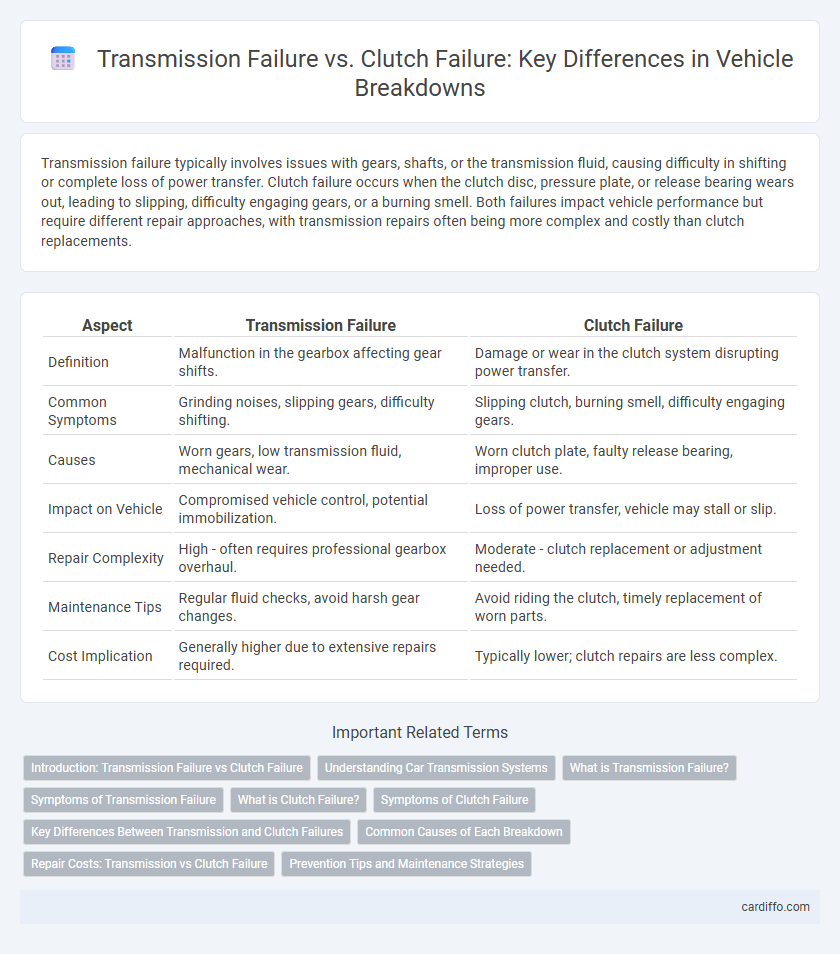Transmission failure typically involves issues with gears, shafts, or the transmission fluid, causing difficulty in shifting or complete loss of power transfer. Clutch failure occurs when the clutch disc, pressure plate, or release bearing wears out, leading to slipping, difficulty engaging gears, or a burning smell. Both failures impact vehicle performance but require different repair approaches, with transmission repairs often being more complex and costly than clutch replacements.
Table of Comparison
| Aspect | Transmission Failure | Clutch Failure |
|---|---|---|
| Definition | Malfunction in the gearbox affecting gear shifts. | Damage or wear in the clutch system disrupting power transfer. |
| Common Symptoms | Grinding noises, slipping gears, difficulty shifting. | Slipping clutch, burning smell, difficulty engaging gears. |
| Causes | Worn gears, low transmission fluid, mechanical wear. | Worn clutch plate, faulty release bearing, improper use. |
| Impact on Vehicle | Compromised vehicle control, potential immobilization. | Loss of power transfer, vehicle may stall or slip. |
| Repair Complexity | High - often requires professional gearbox overhaul. | Moderate - clutch replacement or adjustment needed. |
| Maintenance Tips | Regular fluid checks, avoid harsh gear changes. | Avoid riding the clutch, timely replacement of worn parts. |
| Cost Implication | Generally higher due to extensive repairs required. | Typically lower; clutch repairs are less complex. |
Introduction: Transmission Failure vs Clutch Failure
Transmission failure and clutch failure both lead to drivetrain breakdowns but differ significantly in causes and symptoms. Transmission failure typically involves issues with gears, hydraulic systems, or electronic controls, resulting in difficulty shifting or loss of power transfer. Clutch failure primarily arises from worn friction material or mechanical damage, causing slipping, chattering, or inability to engage gears properly.
Understanding Car Transmission Systems
Transmission failure occurs when the system responsible for transferring power from the engine to the wheels malfunctions, causing shifting issues or complete loss of drive. Clutch failure specifically affects manual transmissions, resulting in slipping, difficulty changing gears, or inability to engage the drivetrain. Understanding car transmission systems involves knowing that the clutch connects and disconnects the engine from the transmission, while the transmission manages gear ratios to optimize power delivery and vehicle performance.
What is Transmission Failure?
Transmission failure occurs when the system responsible for transferring power from the engine to the wheels malfunctions, leading to difficulties in shifting gears or complete loss of vehicle movement. It typically involves damaged gears, worn-out synchronizers, or hydraulic issues within the transmission assembly. Unlike clutch failure, which affects the connection between the engine and transmission, transmission failure directly impacts the internal mechanisms that control gear engagement and power distribution.
Symptoms of Transmission Failure
Transmission failure symptoms include difficulty shifting gears, slipping gears, and strange noises like grinding or whining during operation. Drivers may experience delayed acceleration and fluid leaks, often accompanied by a burning smell indicating overheating components. Warning lights on the dashboard, such as the check engine or transmission temperature light, commonly signal impending transmission issues.
What is Clutch Failure?
Clutch failure occurs when the clutch system in a vehicle is unable to engage or disengage the engine from the transmission, leading to difficulty in shifting gears or complete loss of power transfer. Common symptoms include slipping clutch, burning smell, and difficulty in pressing the clutch pedal. Causes of clutch failure often involve worn clutch plates, damaged pressure plates, or hydraulic system leaks, requiring timely inspection and replacement to prevent transmission damage.
Symptoms of Clutch Failure
Symptoms of clutch failure include difficulty shifting gears, a burning smell, and a spongy or sticking clutch pedal. Common signs are clutch slippage under acceleration, unusual noises when pressing the clutch, and reduced power transfer causing vehicle stalling or jerking. Diagnosing these symptoms early helps differentiate clutch failure from transmission issues, which typically involve gear grinding or complete inability to engage gears.
Key Differences Between Transmission and Clutch Failures
Transmission failure primarily involves issues within the gearbox, such as damaged gears, worn bearings, or fluid leaks that disrupt power transfer from the engine to the wheels. Clutch failure, on the other hand, is mostly caused by worn clutch plates, slipping, or hydraulic problems that prevent proper engagement and disengagement of the engine from the transmission. Understanding these differences is crucial for diagnosing breakdowns accurately and ensuring targeted repairs to restore vehicle functionality.
Common Causes of Each Breakdown
Transmission failure often results from worn-out gears, low transmission fluid levels, or damaged torque converters, leading to slipping or difficulty in gear shifts. Clutch failure commonly arises from excessive friction, worn clutch plates, or hydraulic system leaks, causing issues like slipping, grabbing, or inability to disengage the clutch. Both failures are frequently caused by poor maintenance, heavy towing, or aggressive driving habits.
Repair Costs: Transmission vs Clutch Failure
Transmission failure repair costs typically range from $1,800 to $3,400 due to complex internal components and labor-intensive processes. Clutch failure repairs are generally less expensive, averaging between $500 and $1,200, as they involve replacing fewer parts and simpler labor. Choosing timely maintenance can significantly reduce the risk of costly transmission overhauls compared to clutch replacements.
Prevention Tips and Maintenance Strategies
Transmission failure often results from low or contaminated fluid, overheating, and worn components, so regular fluid checks, timely replacements, and proper cooling system maintenance are critical to prevention. Clutch failure typically stems from excessive slipping, improper adjustment, or worn friction materials; avoiding riding the clutch pedal and ensuring periodic inspection and adjustment help prolong clutch life. Implementing a routine maintenance schedule, including fluid changes and system diagnostics, reduces the risk of both transmission and clutch failures, enhancing overall vehicle reliability.
Transmission failure vs clutch failure Infographic

 cardiffo.com
cardiffo.com